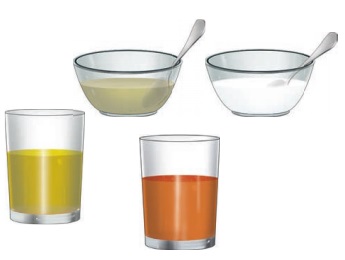Term 3 Unit 3 | 6th Science - Chemistry in Everyday life | 6th Science : Term 3 Unit 3 : Chemistry in Everyday life
Chapter: 6th Science : Term 3 Unit 3 : Chemistry in Everyday life
Chemistry in Everyday life
Unit 3
Chemistry in Everyday life


Learning
Objectives
• To
understand the importance of science in everyday life
• To
understand the preparation of soaps and detergents
• To
know about kinds of fertilizers and its uses
• To
know about uses of cement, gypsum, Epsom, and plaster of paris
• To
know about uses of phenols and adhesives in day to day life
Introduction
We have studied
earlier about the physical changes and chemical changes. Can you identify, from
the following list which are physical changes and which are chemical changes?
• breaking of a
stick into two pieces
• burning of a
paper
• tearing paper
into small pieces
• dissolving of
sugar in water
• burning of petrol
or LPG gas
• water boiling
into water vapour
• coconut oil
becoming solid during winter
Can you see the
important difference between the chemical change and physical change? When you
cut a paper into two, both are still paper pieces, but once you burn it, there
is no longer the paper, only some ash and the smoke is mixed with the air.
Chemical change results in the change of the substance;
In physical change only the shape, size or volume changes;
the state of the matter may also change, from liquid to gas or from liquid to
solid, however the substance remains, chemically as it is.
Let us do the
following experiment. Add a pinch of turmeric powder to water; water turns
yellow. Take a small quantity of soap water in a beaker and add a pinch of
turmeric powder to it. Now, What happens? Is there any change in colour of the
solution? Is it also turning to yellow or to some other colour?

Try adding turmeric
powder to various household liquids and observe the result. Try it on, say,
tamarind extract. Try it on with cleaning liquids in the house. Does it change
the colour?
Chemists identify
turmeric powder as a ‘natural indicator’. The change in colour indicates
that the material is either acid or base medium.
Find answer for the
following questions with the help of your teacher. This will help you to
understand how chemistry plays vital role in our life.
• How does milk
change into curd?
• How can you
remove stain on the copper vessels?
• Idli is a little
bit hard while we cook by using newly grinded idli dough but it is soft with
old dough. Why?
• How does rusting
of iron happen?
• Why does white
sugar change into black when heating?
We can understand
the chemical changes that happen around us by knowing the answers for the above
questions.
We use chemical
changes in various forms in our daily life. Chemistry is the branch of
science which deals with the study of particles around us. The beauty of
chemistry is that, it explains the properties of the basic components of
particles such as atoms and molecules and the effects of their combination.
We can consider all
the particles around us as chemicals. The water (H2O) we drink is
the combination of hydrogen and oxygen. The salt (NaCl) we use in our kitchen
is a combination of the chemicals, sodium and chlorine. Even our body is made
up of a lot of chemical particles.
When
we cut onion, we get tears in the eyes with irritation, because of the presence
of a chemical, propanethial s-oxide in onion. This is easily volatile. When we
cut onion some of the cells are damaged and this chemical comes out. It becomes
vapour and reach our eyes result in irritation and tears in eyes. When we crush
the onion, more cells will be damaged and more chemicals come out.

We could prepare
soft idly as a result of a chemical change named fermentation takes place in
the idly batter. During fermentation the idly batter undergoes a chemical
change by bacteria. While cooking, the food products undergo so many chemical
changes. As a result there are favourable changes in colour, flavour and taste
in the food.
We can use chemical
changes to produce certain materials. For example, some of the objects such as
soaps, fertilizers, plastics and cement which we use in our daily life can be
prepared by making chemical changes in some naturally occurring objects.
Activity 1: Discuss
with your group and list out few chemicals which we use in our home and
school.
_____ ______ ______ ______
We can study about the manufacturing processes and usages of certain materials we use in our daily life such as soaps, fertilizers, cement, gypsum, Epsom, plaster of paris, phenol and adhesives in this lesson.
Related Topics